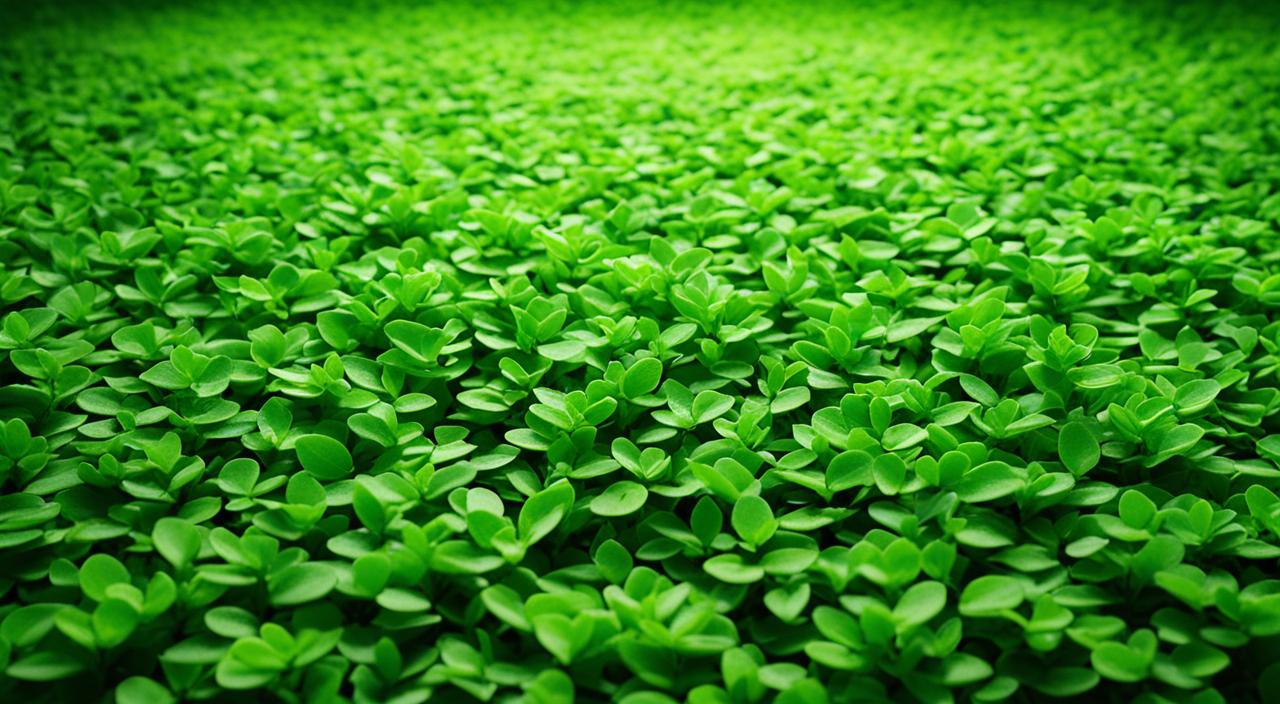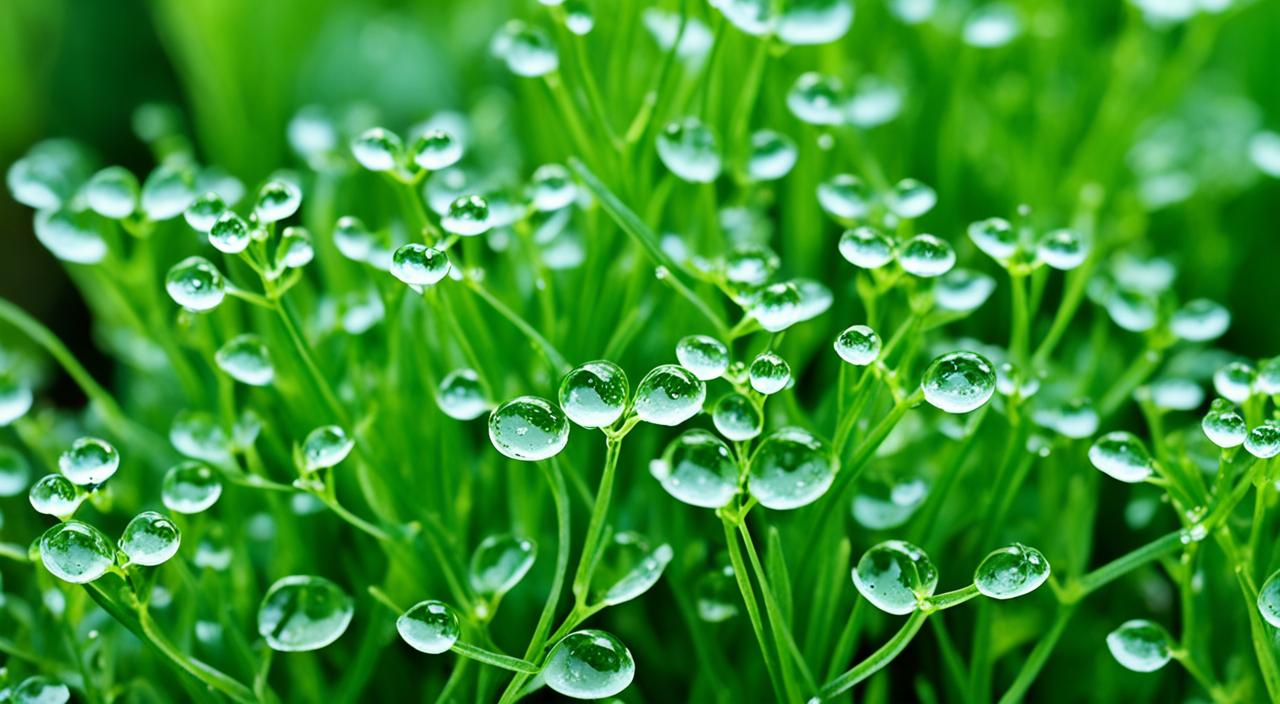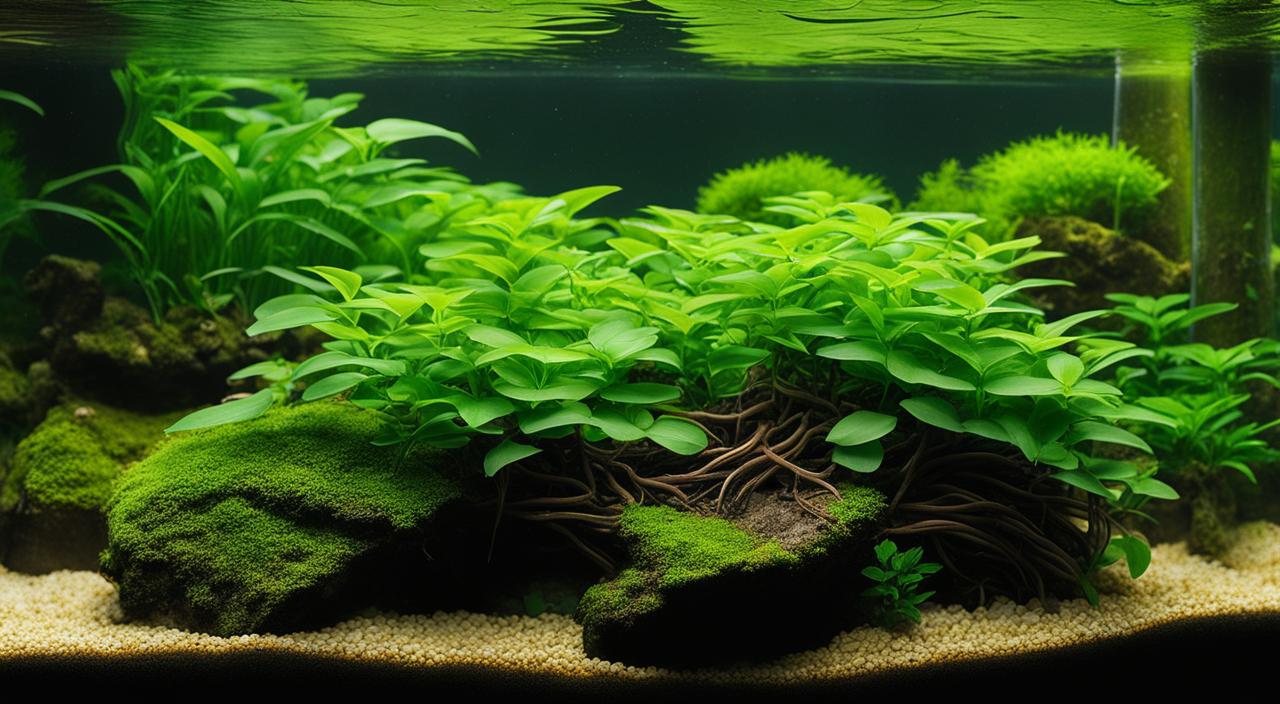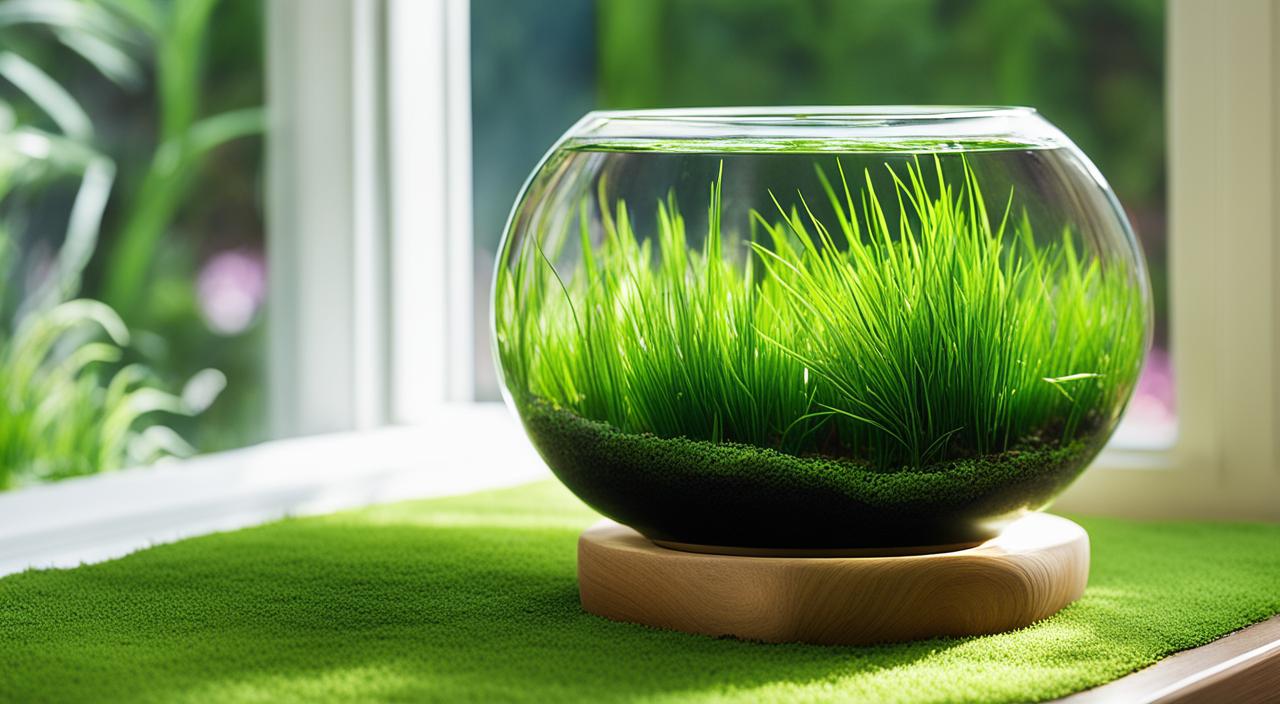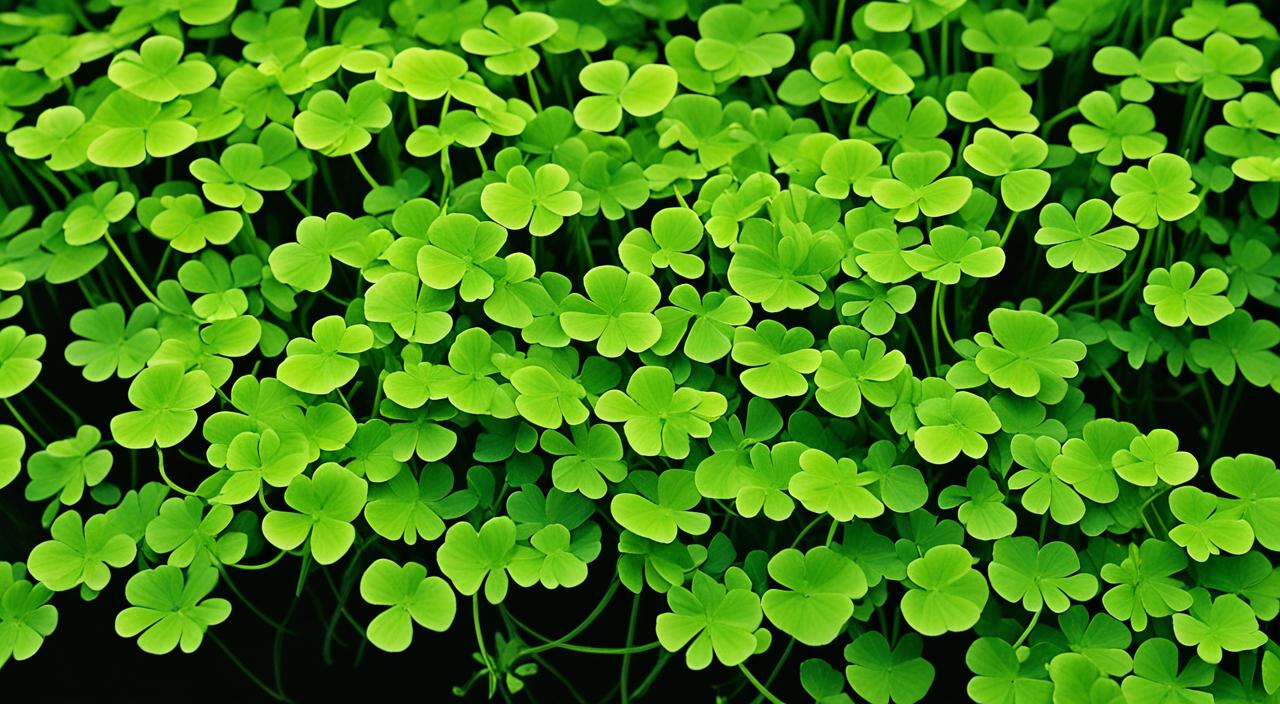Are you looking for a stunning aquatic plant to create a lush carpet in your freshwater aquarium? Look no further than Monte Carlo (Micranthemum tweediei). This popular plant, native to Argentina, is known for its vibrant green colour and ability to form a dense, low-growing ground cover. In this article, I will provide all the information you need to care for and maintain Monte Carlo successfully in your aquarium.
Monte Carlo is often compared to Hemianthus Callitrichoides (HC/Dwarf Baby Tears), but with larger leaves and easier growing conditions. It requires high lighting and CO2 supplementation to thrive and maintain its compact form. Whether you’re a beginner or an experienced aquarist, Monte Carlo is a fantastic choice for creating a visually captivating aquascape.
Key Takeaways:
- Monte Carlo (Micranthemum tweediei) is a popular aquarium ground cover plant known for its vibrant green colour and ability to form a dense carpet.
- This plant requires high lighting and CO2 supplementation for optimal growth and maintenance.
- Monte Carlo is adaptable to submerged and emersed growth and is commonly used in dry start aquariums and Wabi Kusa setups.
- Proper placement, lighting, and care are essential for achieving the desired carpeting effect and maximizing the plant’s visual impact.
- When choosing tank mates, opt for small, peaceful fish species and avoid aggressive fish that may damage the delicate foliage of Monte Carlo.
Brief Overview Of Monte Carlo (Micranthemum tweediei)
Monte Carlo (Micranthemum tweediei) is highly favoured in aquarium aquascaping due to its ability to create a beautiful carpeting effect in the foreground of your tank. Its small, round leaves provide a vibrant green colour that adds depth and visual interest to your aquatic landscape. This marine plant is considered a high-light species, requiring intense lighting conditions to thrive. Additionally, CO2 supplementation is necessary to achieve its full potential.
| Characteristics | Monte Carlo (Micranthemum tweediei) |
|---|---|
| Scientific Name: | Micranthemum tweediei |
| Common Names: | Monte Carlo |
| Origin: | South America |
| Height: | 1-2 cm (ground cover) |
| Growth Rate: | Moderate |
| Colour: | Bright green |
| Aquarium Placement: | Foreground as a carpeting plant |
| Water Type: | Freshwater |
| pH: | 6.0 – 7.5 |
| Care Level: | Moderate |
| Light Requirements: | High light demand, 40-70 PAR, best at 6500K to 7000K Kelvin for optimal growth |
| CO2 Requirements: | Recommended for robust growth |
| Temperature: | 20°C – 26°C (68°F – 78°F) |
| Flow Rate: | Moderate (ensures nutrient distribution and prevents algae) |
| Propagation: | Runners (stolons) or cutting and replanting of healthy shoots |
| Feed Type: | Benefits from liquid fertilizers and a nutrient-rich substrate |
The light requirements for Monte Carlo are quite specific for optimal growth. It thrives under high lighting conditions, with an ideal PAR (Photosynthetically Active Radiation) value of 40-70. The Kelvin scale, which measures the colour temperature of light, should ideally be between 6500K and 7000K, mimicking natural daylight and promoting healthy photosynthesis. This light spectrum not only encourages growth but also helps maintain the vibrant green colour of the plant.
One of the significant advantages of Monte Carlo is its relatively low-maintenance nature. This makes it an ideal choice for beginner and experienced aquarists who want to achieve a lush, carpet-like appearance in their aquariums without investing too much effort in maintenance. With proper care, maintenance, and suitable lighting, Monte Carlo can form a dense carpet that enhances the overall aesthetics of any freshwater aquarium.
Origins And Habitat
Monte Carlo (Micranthemum tweediei) originated in Argentina as a freshwater plant. It is commonly found in marshy areas and along the banks of rivers and streams. This plant thrives in moist environments and is well-adapted to submerged and emersed growth. Monte Carlo forms dense mats in its natural habitat that serve important ecological functions. These mats help stabilize the soil, prevent erosion, and shelter tiny aquatic organisms.
Due to its adaptability and attractive carpeting effect, Monte Carlo has become popular among aquarium hobbyists. Many enthusiasts seek to recreate the lush carpeting look in their tanks, and Monte Carlo is an excellent option. It not only adds visual appeal but also contributes to the overall health and balance of the aquarium ecosystem.
To propagate Monte Carlo, you can cut new growth along with the roots and replant them in the substrate. This allows the plant to spread and form a carpet-like appearance. Proper care and maintenance allow your Monte Carlo carpet to thrive and create a stunning underwater landscape in your aquarium.
Morphological Characteristics
Monte Carlo (Micranthemum tweediei) is characterized by its small, rounded leaves that grow densely along thin stems. The leaves have a bright green colouration that adds vibrancy to the tank. This plant typically reaches a height of 1-2 inches when fully grown. It requires high lighting and CO2 supplementation to maintain its compact and low-growing form. Monte Carlo thrives in slightly acidic to neutral pH conditions, with a range of 6-7.5 being ideal for its growth. When planting or propagating Monte Carlo, it’s important to ensure that the roots are securely anchored in the substrate for proper nutrient uptake.
Placement And Lighting
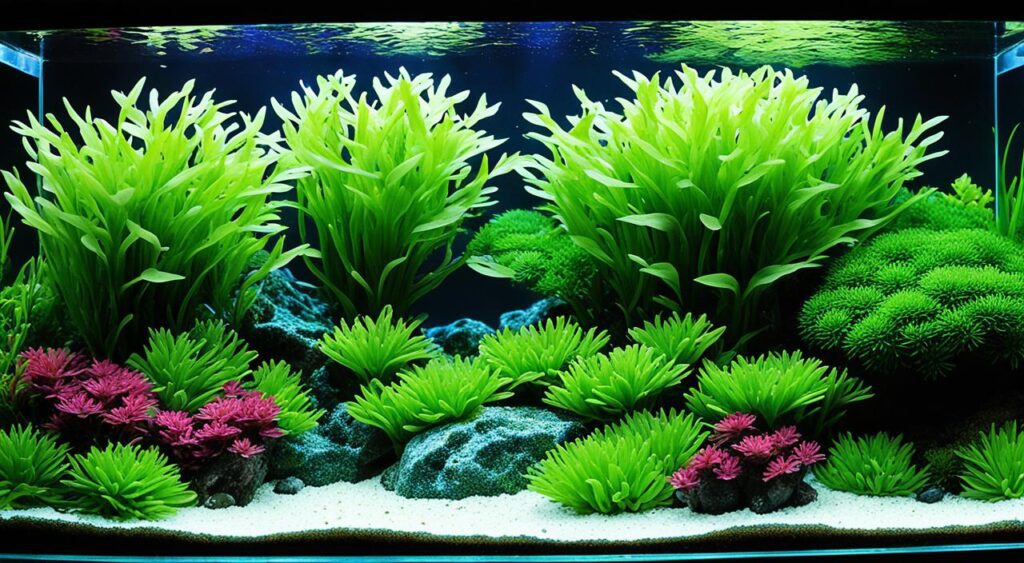
When it comes to incorporating Monte Carlo (Micranthemum tweediei) into your freshwater aquarium, proper placement and lighting are crucial for its growth and aesthetic appeal. This highlight aquatic plant is best suited for the foreground, where it can create a lush carpeting effect.
To ensure optimal growth, Monte Carlo requires high lighting levels of at least 3 watts per gallon or an equivalent LED lighting system. Insufficient lighting will result in vertical growth and thin stalks, compromising the plant’s visual impact.
In addition to appropriate lighting, CO2 supplementation is essential for maintaining healthy and compact growth. CO2 ensures the plant receives sufficient carbon for photosynthesis, promoting vibrant foliage and overall plant health.
When planting Monte Carlo, it is crucial to anchor the roots securely in the substrate to prevent floating or uprooting. This can be achieved by gently pressing the plant into the substrate and ensuring the roots are firmly in place.
Proper placement and lighting are vital for achieving the desired carpeting effect and maximizing the visual impact of Monte Carlo in your aquarium. With the right conditions, this plant will thrive and enhance the overall beauty of your aquascape.
| Placement And Lighting for Monte Carlo (Micranthemum tweediei) | |
|---|---|
| Placement | Ensure roots are securely anchored in the substrate to prevent floating or uprooting. |
| Lighting | High lighting levels of at least 3 watts per gallon or equivalent LED lighting system |
| CO2 Supplementation | Crucial for maintaining healthy and compact growth |
| Root Anchoring | Ensure roots are securely anchored in the substrate to prevent floating or uprooting |
What Are Good Tank Mates?
Monte Carlo (Micranthemum tweediei) is a versatile aquatic plant that can be kept with various freshwater fish and invertebrates. It creates a beautiful carpeting effect in the aquarium, adding a lush and vibrant element to the underwater landscape. When choosing tank mates for Monte Carlo, it is crucial to consider their compatibility with the plant’s growth requirements and the potential for any damage or disruption to the delicate foliage.
Good Tank Mates
Some suitable tank mates for Monte Carlo include:
- Neon Tetras
- Guppies
- Otocinclus Catfish
These small fish species are compatible with the low-growing nature of Monte Carlo and can coexist without disturbing or uprooting the plant. They add colour and movement to the aquarium while maintaining a peaceful and harmonious environment.
Fish Species To Avoid
While many fish can peacefully coexist with Monte Carlo, there are some species to avoid due to their potential to damage or consume the plant:
- Cichlids
- Goldfish
These fish are known for their digging behaviour and may uproot or damage the delicate foliage of Monte Carlo. It is best to avoid keeping them together in the same tank to ensure the plant’s proper growth and longevity.
Invertebrates such as freshwater shrimp and snails can also be safely kept with Monte Carlo, as they do not threaten the plant’s well-being. They can help maintain a clean and balanced ecosystem by consuming algae and decaying plant matter.
Feeding (Fertilization)
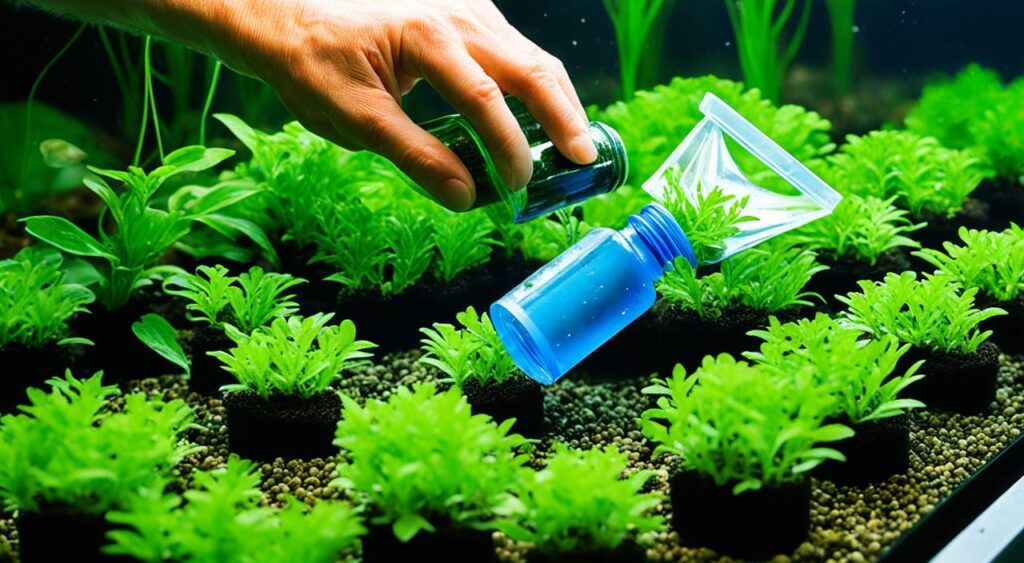
How Much And How Often To Feed
Monte Carlo (Micranthemum tweediei) obtains most of its nutrients from the water column and through its roots. Regular fertilization is beneficial for this low-maintenance aquarium carpet plant to ensure healthy growth and vibrant foliage. Adding liquid fertilizers formulated explicitly for aquarium plants according to the manufacturer’s instructions can provide essential nutrients. Additionally, CO2 supplementation is crucial for providing carbon, which is vital to plant growth.
When it comes to feeding Monte Carlo, following a weekly fertilization schedule with small, regular doses is recommended. This allows for a steady supply of nutrients without overloading the plant or causing nutrient imbalances. Overfertilizing can lead to excessive algae growth and other complications, so monitoring the plant’s health and adjusting the fertilizer dosage accordingly is essential.
Pay attention to the plant’s appearance and adjust the feeding regimen as needed to maintain optimal growth and overall health. A well-balanced fertilization routine and proper CO2 supplementation will help promote vibrant and lush Monte Carlo carpets in your aquarium.
CO2 Injection
CO2 supplementation is essential for successfully growing Monte Carlo (Micranthemum tweediei), especially in high-light aquarium setups. It provides the plant with the necessary carbon for photosynthesis, promoting healthy growth and vibrant foliage. There are various methods of CO2 injection available, including pressurized CO2 systems, DIY CO2 reactors, and liquid carbon supplements. Pressurized CO2 systems offer precise control over CO2 levels and are recommended for larger aquariums or tanks with high lighting. DIY CO2 reactors and liquid carbon supplements can be used in smaller setups or for low to medium-light planted tanks. The choice of CO2 injection method depends on the tank size, lighting intensity, and the aquarist’s preferences.
Care
Managing Monte Carlo (Micranthemum tweediei) involves maintaining specific parameters in the planted tank. The health and growth of this plant rely on creating the ideal environment for its development.
Planted Tank Parameters
To ensure optimal growth, it is vital to provide Monte Carlo with the right conditions. The recommended water temperature for this plant is between 72-82°F (22-28°C). It thrives in moderate to high light conditions, requiring at least 3 watts per gallon or an equivalent LED lighting system. This ensures that the plant receives enough light energy for photosynthesis and growth. It is important to note that insufficient light may result in elongated stems and weak growth.
Water Quality
Maintaining good water quality is crucial for the health of Monte Carlo. Regular water testing is recommended to monitor the ammonia, nitrite, and nitrate levels, as this plant can be sensitive to high levels of these compounds. Ammonia and nitrite should ideally be at zero, while nitrate levels should be below 20 ppm. Performing regular water changes helps to keep these parameters in check and provides a fresh supply of nutrients for the plant.
Filtration
Adequate filtration is essential for maintaining water quality and preventing the build-up of waste materials. A reliable filtration system will remove excess nutrients and debris from the water column, minimizing the risk of algae growth and maintaining optimal conditions for Monte Carlo’s growth. A combination of mechanical, biological, and chemical filtration is recommended for effective water filtration and filtration media should be regularly cleaned or replaced to ensure optimal performance.
Flow
Proper water flow is essential to prevent stagnant aquarium areas and distribute nutrients evenly. Monte Carlo prefers moderate water flow to avoid debris and waste from settling on its leaves. Positioning the filter outlet strategically and incorporating circulation pumps or powerheads can help achieve optimal water flow within the tank. It is vital to balance providing sufficient flow for the plant’s health and avoiding excessive flow that may damage the delicate foliage.
Aquarium Maintenance
Regular aquarium maintenance is crucial for the health and growth of Monte Carlo (Micranthemum tweediei). To ensure optimal water quality and a thriving environment for your plants and fish, it is crucial to test the water conditions, set up your aquarium tank correctly, and understand the propagation methods for Monte Carlo.
Testing Water Conditions
Testing the water conditions is essential to maintaining a healthy aquarium ecosystem. You can use a reliable test kit to monitor parameters such as ammonia, nitrite, nitrate levels, pH, and other vital factors. Regular testing allows you to identify any imbalances or issues that may affect the well-being of your plants and aquatic life. Proper water quality is crucial for the success of Monte Carlo and the overall health of your aquarium.
How To Set Up Your Aquarium Tank
When setting up your aquarium tank for Monte Carlo, creating a suitable environment that promotes growth and stability is crucial. Start by choosing a substrate that will securely anchor the plant’s roots. This can be a nutrient-rich substrate designed explicitly for aquatic plants or a combination of gravel and root tabs. Proper substrate ensures that Monte Carlo receives the necessary nutrients for its growth.
Additionally, consider the placement of other elements in your tank, such as rocks and driftwood, to complement the appearance of Monte Carlo. Ensure the tank is adequately cycled before introducing Monte Carlo or any other aquatic life.
Propagation Methods
Monte Carlo propagation allows you to expand and maintain a lush carpet of plants in your aquarium. To propagate Monte Carlo, you can use cuttings of new growth along with roots. Carefully replant these cuttings in the substrate, ensuring the roots are securely anchored. With proper care and maintenance, the plant will continue to spread and form a dense carpet, enhancing the overall aesthetics of your aquarium.
Regular care and attention to the maintenance aspects of your aquarium will contribute to the longevity and success of your Monte Carlo carpet. By testing water conditions, setting up the tank correctly, and understanding the propagation methods, you can create a thriving environment for your plants and aquatic life, ensuring your aquarium ecosystem’s continued beauty and health.
Health And Disease
Maintaining your Monte Carlo’s (Micranthemum tweediei health is crucial to ensuring its thriving growth in your aquarium. By observing good health signs and promptly addressing any issues, you can keep your Monte Carlo carpet looking vibrant and lush.
Signs Of Good Health
A healthy Monte Carlo carpet displays several vital signs. The foliage should be vibrant green, indicating proper nutrient absorption and photosynthesis. The growth should be compact, with new leaves forming regularly. A dense carpeting effect is achieved when the plant propagates and spreads across the substrate, effectively filling empty spaces.
Signs Of Poor Health
Signs of poor health in Monte Carlo can manifest in various ways. Yellowing or wilting leaves indicate a potential nutrient deficiency, such as a lack of iron or other essential compounds. Weak growth and stunted or thinning patches in the carpet may suggest inadequate lighting or CO2 levels. It is essential to monitor the overall condition of the plant to detect any signs of poor health early.
Common Health Issues And Treatment
Common health issues for Monte Carlo include nutrient deficiencies, algae growth, and plant pests. Nutrient deficiencies can be addressed by appropriate fertilization and supplementing specific nutrients in the tank. Algae growth can be controlled by maintaining proper water parameters, ensuring sufficient water circulation, and reducing excessive light exposure. Plant pests like snails or aphids can be managed through manual removal or targeted treatments that are safe for aquatic plants.
Plant Pests
Plant pests, such as snails or aphids, can be a nuisance for Monte Carlo. Snails, for example, can devour the foliage and leave unsightly holes or damage behind. Manual removal of snails is one effective method, but it may require consistent effort. Avoid introducing new plants or decor that may carry pests into your aquarium. Regular observation and prompt action can help manage and prevent plant pest infestations.
Summary
Monte Carlo (Micranthemum tweediei) is a versatile and visually striking plant that can create a beautiful carpeting effect in freshwater aquariums. With its vibrant green foliage and low-growing nature, it adds depth and visual interest to any aquascape. When provided with high lighting, adequate CO2 supplementation, and proper care, Monte Carlo can form a dense carpet that enhances the overall aesthetics of the tank. Regular trimming and maintenance are necessary to keep it in shape. Its relatively low-maintenance nature makes it popular for beginner and experienced hobbyists looking to create lush and vibrant aquascapes.
Monte Carlo is known for its ability to form a lush carpet in aquariums, making it an ideal choice for aquascaping. It requires high lighting and CO2 supplementation to thrive and achieve its full potential. This plant originates from Argentina and features small, round leaves with a vibrant green color. Compared to Hemianthus callitrichoides, Monte Carlo has larger leaves and is easier to grow, making it favoured by many aquarists.
When planting Monte Carlo, it is essential to anchor the roots securely in the substrate to ensure proper nutrient uptake. This plant can be planted submerged or emersed and is commonly used in dry start aquariums and Wabi Kusa setups. It is highly adaptable and can grow in various freshwater tank setups, adding beauty and depth to the aquarium.
With its reputation as a low-maintenance plant, Monte Carlo suits both beginner and experienced hobbyists. It can coexist with many freshwater fish and invertebrates, making it a versatile addition to any aquarium. Regular fertilization, CO2 supplementation, and proper water quality maintenance are essential for the health and growth of Monte Carlo. Overall, Monte Carlo is popular for creating a stunning and vibrant aquatic carpet in their freshwater aquariums.
FAQ
What is Monte Carlo (Micranthemum tweediei)?
Monte Carlo is a popular aquatic plant known for its ability to form a lush carpet in freshwater aquariums. It originates from Argentina and features small, round leaves with a vibrant green color.
How do I care for Monte Carlo?
Monte Carlo requires high lighting and CO2 supplementation to thrive. Regular trimming is necessary to maintain its low growth. It can be planted submerged or emersed and is commonly used in dry start aquariums and Wabi Kusa setups.
What are some good tank mates for Monte Carlo?
Good tank mates for Monte Carlo include small fish species like neon tetras, guppies, and otocinclus catfish. It’s important to avoid large and aggressive fish species that may damage or uproot the plant.
How should I feed Monte Carlo?
Monte Carlo obtains most of its nutrients from the water column. Regular fertilization with liquid fertilizers specifically formulated for aquarium plants is recommended. CO2 supplementation is also crucial for its growth.
What types of CO2 injection methods can I use for Monte Carlo?
Pressurized CO2 systems, DIY CO2 reactors, and liquid carbon supplements are common methods of CO2 injection. The choice depends on the tank size, lighting intensity, and personal preferences.
What are the ideal planted tank parameters for Monte Carlo?
Monte Carlo thrives in water temperatures between 72-82°F (22-28°C) and a pH range of 6-7.5. It requires moderate to high lighting levels and proper water circulation and filtration to maintain optimal conditions.
How do I propagate Monte Carlo?
Monte Carlo can be propagated by cutting new growth along with roots and replanting them in the substrate. With proper care, the plant will continue to spread and form a dense carpet.
What are the signs of good and poor health in Monte Carlo?
Signs of good health in Monte Carlo include vibrant green foliage, compact growth, and new leaf formation. Signs of poor health may include yellowing or wilting leaves, weak growth, or thinning patches in the carpet.
What are common health issues and pests that can affect Monte Carlo?
Common health issues for Monte Carlo can include nutrient deficiencies, algae growth, and plant pests like snails or aphids. Proper fertilization, water quality maintenance, and pest control measures are necessary to address these issues.
Is Monte Carlo a low-maintenance aquarium plant?
Yes, Monte Carlo is considered a low-maintenance plant. With the right conditions and care, it can thrive and form a beautiful carpet in the aquarium.
Can Monte Carlo be used in aquascaping?
Absolutely! Monte Carlo is highly favored in aquascaping due to its ability to create a lush carpeting effect in the foreground of aquariums. It adds depth and visual interest to the overall design.

